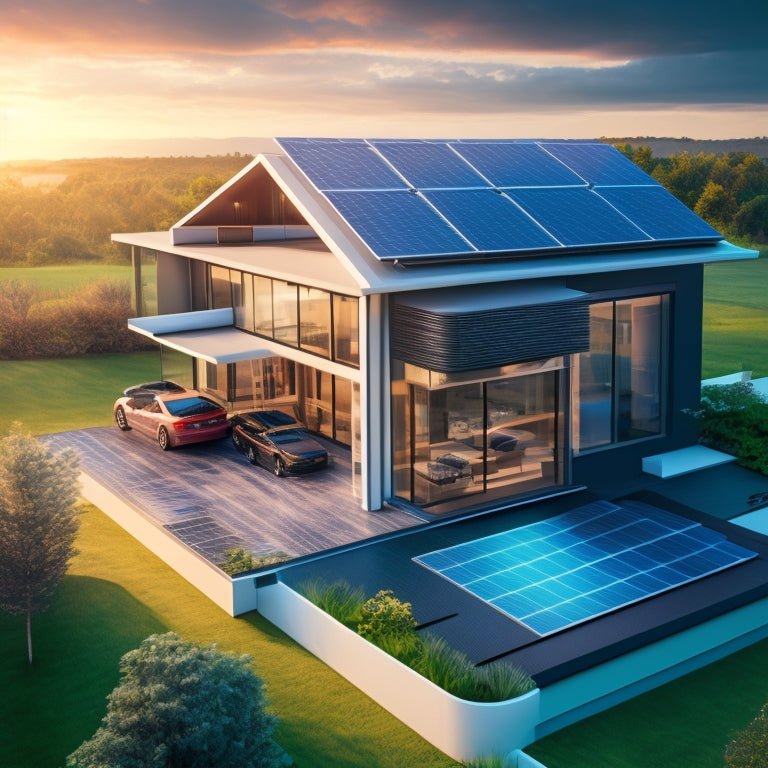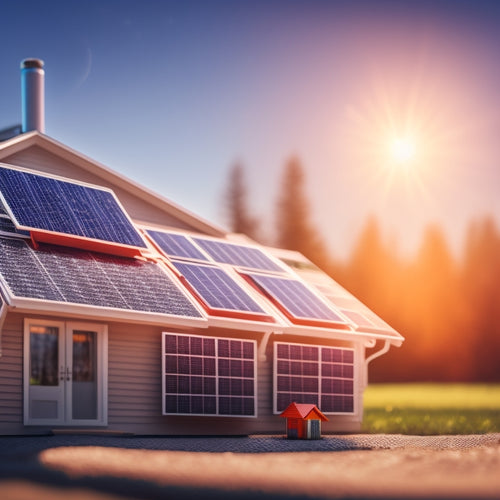
Solar Power Storage Options
Share
You're considering solar power storage options to reduce your dependence on the grid and lower your electricity bills, and with the right system, you can store up to 80% of your excess energy for later use. Deep cycle batteries are a key component, and understanding their cycle life expectancy and depth of discharge is essential for ideal performance. Evaluating your energy demands and daily peak hours helps determine the necessary storage capacity. By selecting a high-efficiency power conversion system with advanced features like maximum power point tracking, you can maximize your energy independence. Now, take the next step to reveal the full potential of solar power storage.
The Essentials
- Solar battery storage systems manage excess energy, reducing energy bills and reliance on the grid.
- Deep cycle batteries store excess energy for nighttime or cloudy usage, optimizing power usage and reducing waste.
- High-performance batteries with long cycle life expectancy and moderate depth of discharge (DOD) are crucial for efficient energy storage.
- Energy audits and efficient power conversion systems with maximum power point tracking (MPPT) enhance energy collection and independence.
- Smart devices and real-time energy data help identify inefficiencies, reducing energy consumption and contributing to a lower carbon footprint.
Reduce Carbon Footprint Now
You're likely aware that reducing your carbon footprint is essential for a sustainable future, and you're taking the right step by exploring eco-friendly energy solutions.
With the integration of advanced battery systems, such as solar energy storage, you can efficiently utilize and store excess energy generated during the day for use during the night or on cloudy days.
By shifting to renewable energy sources, such as solar power, you'll greatly decrease your reliance on fossil fuels and lower your emissions.
With the right solar power storage options, you can maximize your renewable energy output and minimize your environmental impact.
Eco-Friendly Energy Solutions
Your quest for a reduced carbon footprint begins with embracing eco-friendly energy solutions. As you shift to sustainable practices, you'll find that green technologies play a significant role in minimizing your environmental impact.
Eco-friendly energy solutions focus on utilizing renewable energy sources, efficiently storing excess energy, and reducing reliance on fossil fuels. By adopting these sustainable practices, you'll not only lower your carbon emissions but also reduce your energy bills.
With the integration of solar battery storage systems, you can store excess energy generated during the day for use during the night or on cloudy days, reducing your reliance on the grid.
Furthermore, eco-friendly energy solutions often incorporate smart grid technologies that enable real-time energy monitoring and management, allowing you to make informed decisions about your energy usage.
Renewable Energy Sources
To reduce your carbon footprint now, utilizing renewable energy sources is key. You're not limited to just solar power; there are various options to choose from, each with its benefits and drawbacks. Let's investigate some of the most popular renewable energy sources:
| Renewable Energy Source | Description |
|---|---|
| Wind Energy | Captures power from wind using turbines, ideal for open spaces and coastal areas |
| Geothermal Energy | Taps into Earth's heat to generate electricity, suitable for regions with high volcanic activity |
| Biomass Energy | Produces energy from organic matter like wood, crops, and waste, suitable for rural areas |
These renewable energy sources can be integrated into your existing energy infrastructure, enabling you to adopt sustainable practices and reduce your reliance on fossil fuels. By incorporating wind energy, geothermal energy, biomass energy, and hydropower solutions into your energy mix, you'll be well on your way to achieving renewable integration. With the right combination of these sources, you can enjoy a cleaner, greener, and more independent energy future.
Lower Electricity Bills
By integrating solar power storage into your system, you'll reduce your energy consumption and lower your electricity bills.
With the help of deep cycle batteries and inverter technology Renewable energy systems, you'll be able to store excess energy generated during the day for use during the night or on cloudy days.
You'll achieve this by optimizing power usage, ensuring you use the energy you've generated during the day when you need it most.
As a result, you'll rely less on the grid, leading to significant savings over time.
Reducing Energy Consumption
Among the most notable advantages of solar power storage systems is their ability to drastically reduce your energy consumption, thereby leading to lower electricity bills. By capturing the power of the sun and storing it for later use, you can greatly decrease your reliance on the grid. This not only saves you money but also contributes to a more sustainable future.
To maximize energy efficiency, it's essential to identify areas where energy is being wasted. Conduct an energy audit to pinpoint appliances and devices that consume the most power.
Replace them with energy-efficient alternatives, and adjust your usage habits to reduce standby power consumption. Implementing sustainable practices, such as turning off lights and electronics when not in use, can also make a substantial impact.
Optimizing Power Usage
Approximately 30% of your monthly electricity bill can be attributed to inefficient power usage. This is a significant amount, especially considering you're already generating your own clean energy through solar power.
Optimizing your power usage is essential to minimizing your reliance on the grid and maximizing your energy independence.
By implementing effective energy management strategies, you can reduce your energy waste and lower your electricity bills. One way to achieve this is by incorporating smart devices into your home.
These devices can detect when appliances are in standby mode and cut power to them, eliminating standby power consumption. They can also provide real-time energy usage data, enabling you to identify areas of inefficiency and make adjustments accordingly.
Deep Cycle Battery Life
When evaluating deep cycle batteries for your solar power storage system, you'll want to take into account two key factors: cycle life expectancy and depth of discharge.
To maximize renewable energy storage and reduce reliance on the grid, it's crucial to choose high-performance batteries that can handle frequent charge and discharge cycles solar power system battery.
Cycle life expectancy refers to the number of charge and discharge cycles a battery can handle before its capacity degrades.
You'll need to determine how often you'll need to replace your batteries based on the depth of discharge, which affects the battery's overall lifespan.
Cycle Life Expectancy
Your solar power storage system's lifeblood is its deep cycle batteries, and their cycle life expectancy plays an important role in determining the overall performance and cost-effectiveness of your setup.
The cycle life expectancy of your deep cycle batteries refers to the number of charging cycles they can handle before their capacity degrades to 80% of their original state. A typical deep cycle battery can last for around 300 to 500 charging cycles, depending on factors such as temperature effects, discharge rates, and usage habits.
Proper maintenance, such as keeping the battery terminals clean and ensuring adequate ventilation, can help extend the battery lifespan. However, performance degradation is inevitable, and it's vital to factor this into your cost analysis.
The environmental impact of frequent battery replacements can be significant, so it's important to choose a battery technology that balances performance with sustainability.
Depth of Discharge
Efficiency hinges on the delicate balance between energy storage and consumption, and this balance is heavily influenced by the depth of discharge (DOD) of your deep cycle batteries.
You need to understand how DOD affects your battery's performance and lifespan. DOD refers to the percentage of a battery's capacity that's been drained during a discharge cycle. For example, if you discharge a 100Ah battery to 80Ah, the DOD is 20%.
The ideal DOD varies depending on battery chemistry and discharge rates. For instance, lead-acid batteries should be kept above 50% charge to prolong their lifespan, while lithium-ion batteries can handle deeper discharge cycles.
You'll need to adjust your energy consumption and storage strategies accordingly. If you consistently drain your batteries too deeply, you'll reduce their overall lifespan and increase the risk of premature failure.
Aim for a moderate DOD to strike a balance between energy availability and battery longevity. By doing so, you'll guarantee a reliable and efficient solar power storage system that meets your energy needs while maintaining your freedom from the grid.
Assess Your Energy Demands
You need to understand your energy usage patterns to determine the right solar power storage solution for your needs.
With the rise of renewable energy storage systems like Tesla Powerwall and LG Chem RESU, sizing your storage system correctly is essential solar battery storage.
Identify your daily peak hours, when you use the most energy, to guarantee your storage system provides reliable power when you need it most.
Energy Usage Patterns
As households and businesses increasingly rely on solar power, understanding energy usage patterns becomes essential for effective solar power storage. You need to assess your energy demands to determine the right storage solution for your needs.
To do this, evaluate your energy consumption and usage trends. Identify the times of day when your energy usage is highest and lowest. This information will help you determine the capacity and type of storage system you require.
| Time of Day | Energy Consumption | Usage Trends |
|---|---|---|
| Morning | Low | Steady increase as appliances turn on |
| Afternoon | High | Peak usage during work/school hours |
| Evening | Medium | Decrease as appliances turn off |
Daily Peak Hours
Identifying daily peak hours is essential in evaluating your energy demands, particularly when it comes to solar power storage.
You need to understand when your energy usage is at its highest to determine the right storage capacity for your system. Peak demand typically occurs during morning and evening hours when solar energy production is limited.
This is where load management comes into play, allowing you to shift non-essential loads to off-peak hours, reducing your peak demand and strain on the grid.
High Efficiency Energy Conversion
You'll need power conversion systems that can efficiently convert the DC power generated by your solar panels to AC power for your home or business.
These systems, which include inverters and converters, play an essential role in ensuring that the energy harvested from the sun is successfully stored and employed.
Power Conversion Systems
Three key components comprise a solar power storage system: the solar panel array, the energy storage unit, and the power conversion system.
As you investigate solar power storage options, understanding the power conversion system's role is vital. This system is responsible for converting the DC power generated by your solar panels into usable AC power for your home or business.
The power conversion system's efficiency greatly impacts your overall energy efficiency. A high-efficiency power conversion system minimizes energy losses during conversion, ensuring you get the most out of your solar power.
When selecting a power conversion system, look for one with a high efficiency rating, typically above 95%. This will help you maximize your energy independence and reduce your reliance on the grid.
Additionally, consider a system with advanced features like maximum power point tracking (MPPT) and DC-DC conversion to optimize energy collection.
Frequently Asked Questions
Can I Use Any Deep Cycle Battery for Solar Power Storage?
You can't use just any deep cycle battery; you'll need to choose a compatible type, like flooded, AGM, or lithium-ion, and consider capacity requirements, ensuring your battery meets your energy needs and charging/discharging demands.
Do Solar Power Storage Systems Require Maintenance?
You'll need to perform regular maintenance to guarantee your system's longevity, as neglect can reduce battery lifespan; follow maintenance tips like monitoring voltage, checking connections, and updating software to keep your system running smoothly and efficiently.
Can I Add More Batteries to My Existing System?
Imagine unblocking your system's full potential! You can upgrade your energy independence by adding more batteries, increasing your battery capacity, and expanding your system's capabilities, giving you the freedom to harvest and store even more power.
Are Solar Power Storage Systems Compatible With Grid Power?
You're wondering if you can utilize the power of grid integration to achieve energy independence. The answer is yes, you can integrate solar power storage systems with grid power, allowing you to switch seamlessly between the two and enjoy reliable, self-sufficient energy.
Can I Use Solar Power Storage for My Entire Home?
As you seek independence from the grid, you wonder if solar energy benefits can power your entire home. The answer lies in battery capacity - with a sufficient system, you can utilize enough solar energy to cover all your needs, cutting ties with traditional power sources.
Final Thoughts
As you investigate solar power storage options, remember that every kilowatt-hour counts. Did you know that if the US shifted to 100% solar power, it would reduce carbon emissions by a staggering 78%? By evaluating your energy demands and investing in high-efficiency energy conversion systems, you can greatly lower your electricity bills and reduce your carbon footprint. With deep cycle battery life extending up to 15 years, the benefits of solar power storage are undeniable. Take the first step towards a sustainable future today.
Related Posts
-

A Beginner's Guide to Navigating the Solar Investment Tax Credit
You're eligible to claim a significant Solar Investment Tax Credit (ITC) of 30% of total installation costs, but mane...
-

Solar Powered Lights for Sustainable Home Decor
Solar-powered lights offer a stylish and eco-friendly way to enhance your home decor. They capture sunlight, converti...
-

Top Solar Powered Camping Fans for Camping Enthusiasts
If you're a camping enthusiast, a solar-powered fan can be a transformative element for your outdoor experience. Thes...


